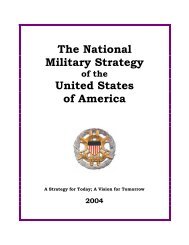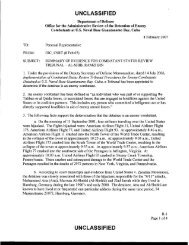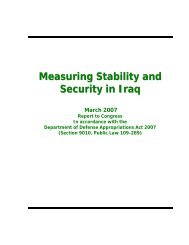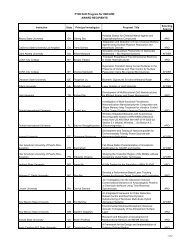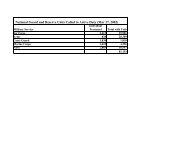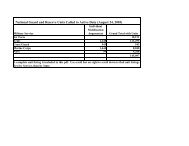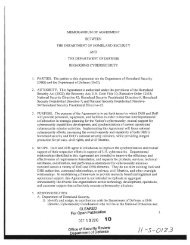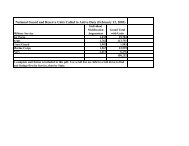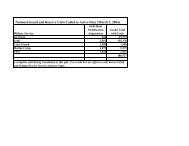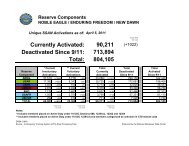Report - United States Department of Defense
Report - United States Department of Defense
Report - United States Department of Defense
Create successful ePaper yourself
Turn your PDF publications into a flip-book with our unique Google optimized e-Paper software.
UNCLASSIFIED<br />
forces and their coordination and communications systems to protect the population, deny enemy<br />
and criminal elements freedom to operate, control key terrain and lines <strong>of</strong> communication and<br />
enable quick-reaction forces to move across the operational area based on intelligence and<br />
assessments. This approach involves employment <strong>of</strong> ANP in the population centers, ANA in<br />
areas surrounding the populations centers and remote enemy support zones and Afghan Border<br />
Police (ABP) in control <strong>of</strong> the major border crossing points, all facilitated by synchronization at<br />
the provincial and regional Operational Coordination Centers (OCCs).<br />
Concurrent and parallel to ANSF efforts, IJC will move to a six-month seasonal operations order<br />
paradigm for achieving campaign objectives under the ISAF OPLAN. The parallel efforts<br />
between ANSF and coalition forces account for the unique mission sets <strong>of</strong> each force, the<br />
transition <strong>of</strong> security responsibility to the ANSF and the competence <strong>of</strong> the ANSF.<br />
Coalition forces have nearly completed their shift to SFA, enabling the ANSF to execute layered<br />
security in key areas with the coalition providing capabilities such as air support, artillery,<br />
Medical Evacuation (medevac) and intelligence, surveillance and reconnaissance (ISR) to<br />
ANSF-conducted operations. These operations are intended to create the conditions for<br />
improved governance from the local to the national level and bolstering GIRoA’s image with the<br />
population.<br />
Coalition forces will continue to reduce and restructure the footprint <strong>of</strong> supporting bases and<br />
infrastructure, recognizing the need to balance the requirement to position forces in support <strong>of</strong><br />
SFA while ensuring the timely and steady retrograde <strong>of</strong> forces and equipment to meet the<br />
transition timeline.<br />
Security Force Assistance<br />
As the ANSF’s capabilities have improved dramatically during the past two years, ISAF units<br />
have transitioned from leading kinetic counter-insurgency (COIN) operations to conducting more<br />
partnered operations with the ANSF increasingly in the lead. These partnered operations<br />
included embedded SFATs designed to train, advise and assist the developing ANSF units.<br />
ISAF is now entering another period <strong>of</strong> transition in 2013 as the ANSF assume security lead in<br />
the population centers and key terrain areas across Afghanistan. As this occurs, ISAF will<br />
transition increasingly to a TAA role designed to more rapidly develop and enable ANSF. In<br />
fact, the ANSF is increasingly taking over planning, preparation and execution <strong>of</strong> COIN<br />
operations with SFATs only providing advice and enabler support to augment lagging ANSF<br />
capabilities that are still under development.<br />
In November 2012, ISAF began employing tailored U.S. SFABs that have been purpose-built to<br />
support the SFA mission, protect the forces and provide critical enablers to ANSF COIN<br />
operations. During the reporting period, the <strong>United</strong> <strong>States</strong> increasingly deployed SFABs instead<br />
<strong>of</strong> regular combat brigades to Afghanistan that are much more suited to the TAA mission.<br />
SFABs will, however, maintain the capability to defend themselves and to carry out independent<br />
combat operations as necessary.<br />
14



